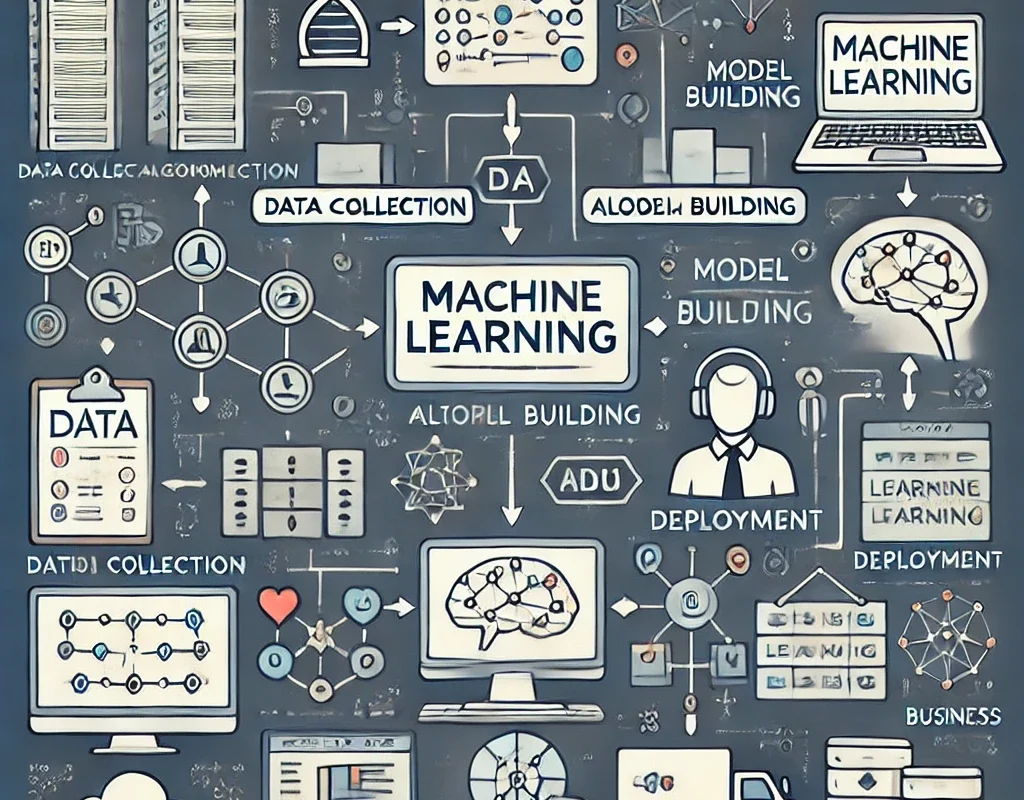Introduction
In the digital age, where data is the new oil, machine learning has emerged as a critical tool for businesses and industries to solve complex problems. The ability to automate processes, predict outcomes, and drive decisions has made machine learning (ML) a game-changer across various sectors. But how do you move from theoretical understanding to real-world implementation? This is where many aspiring data scientists and developers face a hurdle. In this article, we explore how to implement machine learning in real-world projects, discussing each phase of the process, tools to use, and challenges to expect.
Understanding Machine Learning
To implement machine learning in real-world projects, it’s essential to grasp its core concepts. At its heart, machine learning is about building systems that learn from data rather than relying on hard-coded instructions. This allows for predictive analytics and data-driven insights across fields like healthcare, finance, retail, and more.
Key Concepts and Terminologies
Machine learning is typically divided into three types: supervised learning, unsupervised learning, and reinforcement learning. Understanding the differences between these approaches helps to frame your project effectively. For instance, supervised learning is used when labeled data is available, while unsupervised learning deals with discovering hidden patterns in unlabeled data. Additionally, reinforcement learning enables systems to learn from the consequences of their actions, refining decisions through trial and error.
Steps to Implement Machine Learning
Implementing machine learning in real-world projects follows a structured workflow, from defining the problem to deploying and maintaining the model. Let’s dive deeper into each of these steps to clarify the process.
Defining Your Problem
The first step is to define the problem that machine learning can solve. For example, are you aiming to forecast stock prices, detect fraud, or automate customer service? Machine learning excels in tasks where patterns and predictions can improve decision-making. Defining the problem sets the stage for how data will be collected, what algorithms will be selected, and how success will be measured.
Choosing the Right Problem for Machine Learning
Not every problem is suited for machine learning. You need to assess whether enough data is available and whether the problem is one that a machine can reasonably learn from. Typically, problems that involve classification, regression, or clustering lend themselves well to machine learning solutions.
Data Collection and Preparation
Data is the backbone of any machine learning project. The more relevant and clean your data, the better the model will perform. Data can be collected from various sources, such as databases, web scraping, or APIs.
Sources, Cleaning, and Feature Engineering
Data often comes in raw formats, with noise, missing values, and irrelevant information. Cleaning the data through methods like handling missing values and removing duplicates is crucial. Additionally, feature engineering, which involves creating new features from existing data, can significantly improve a model’s accuracy.
Choosing the Right Algorithm
Choosing the right algorithm depends on the nature of your problem and data. Different algorithms have strengths and weaknesses. For example, decision trees are useful for interpretable models, while deep learning excels in handling large datasets like image or speech recognition.
Supervised vs. Unsupervised Learning
Supervised learning works when you have labeled data to train on, making it ideal for prediction tasks like spam detection. Unsupervised learning is more exploratory, helping find patterns in unlabeled data, which is useful in areas like customer segmentation.
Building a Machine Learning Model
Once data is ready, you can begin building your model. This involves splitting the data into training and testing sets, then feeding the training set into the algorithm.
How to Train and Test Models
Training a model involves feeding it data and allowing it to learn from the patterns within it. The performance of the model is then evaluated on the test set, which the model has never seen before. This ensures that the model generalizes well to new data, not just the training data.
Evaluating Model Performance
Evaluating a model is about determining how well it makes predictions. Metrics such as accuracy, precision, recall, and F1 score are used to assess the performance.
Key Metrics for Assessment
Accuracy is often the first metric people think of, but it’s not always the best measure. For instance, in imbalanced datasets (like fraud detection, where fraud cases are rare), accuracy may be misleading. Instead, precision and recall provide a more nuanced view of how well your model is performing.
Optimizing the Model
After evaluating your model, optimization steps follow. This includes hyperparameter tuning to find the best parameters for your model, as well as techniques like regularization to prevent overfitting.
Hyperparameter Tuning and Regularization Techniques
Grid search or random search are common methods for hyperparameter tuning, allowing you to systematically test different combinations of model parameters. Regularization techniques, such as L1 and L2 regularization, help prevent models from overfitting by adding a penalty for complexity.
Deployment of Machine Learning
Once a model has been trained and optimized, it’s time to deploy it in the real world. Deployment can take many forms, from embedding the model in an application to offering it as an API for other systems to interact with.
Integrating ML Models into Real-World Applications
This stage involves working with developers to integrate the model into a software application. If you’re working on a web-based project, deploying the model as a REST API is a common approach. Tools like Flask, Django, or FastAPI can help with this integration.
Monitoring and Maintenance
Machine learning models are not static; they require continuous monitoring and updating to ensure they perform well as new data becomes available.
Ensuring Long-Term Success of the Model
Monitoring model performance over time is crucial. You may need to retrain models as data distributions change, or implement feedback loops where user interactions help improve the model’s accuracy.
Tools for Machine Learning Projects
Today, a variety of tools and platforms exist to simplify the machine learning workflow. Whether you’re working on-premise or in the cloud, having the right tools can accelerate your development.
Choosing the Right Platform
Depending on your infrastructure and project needs, you might choose between on-premise solutions or cloud platforms such as AWS, Google Cloud, or Azure. Cloud platforms are popular due to their scalability and ease of use.
Stay tuned for more in-depth sections on deploying machine learning projects and solving real-world challenges. Additionally, learn how companies have successfully implemented machine learning to drive innovation.



